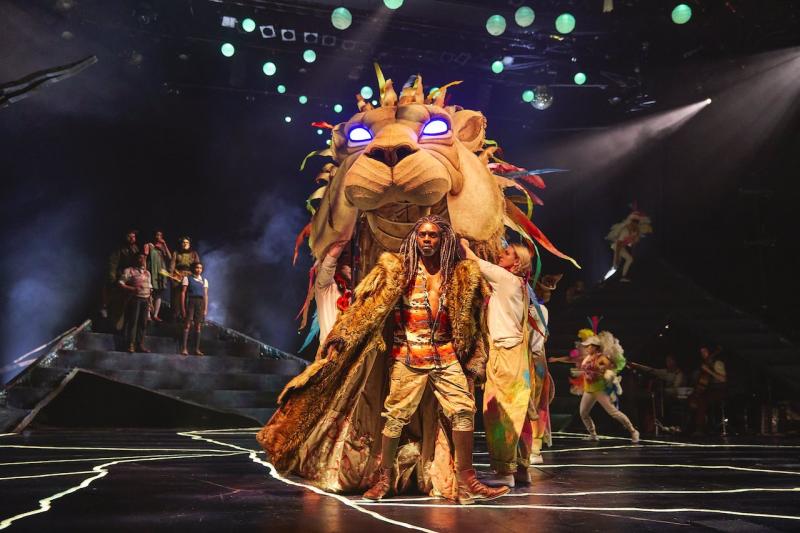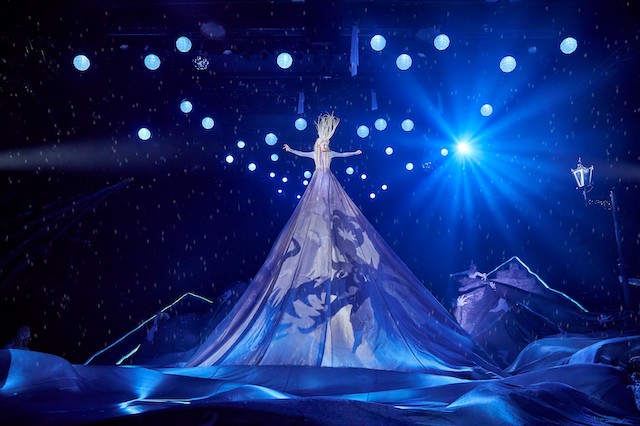The Lion, The Witch and The Wardrobe, Bridge Theatre review – spellbinding narrative of parallel worlds | reviews, news & interviews
The Lion, The Witch and The Wardrobe, Bridge Theatre review – spellbinding narrative of parallel worlds
The Lion, The Witch and The Wardrobe, Bridge Theatre review – spellbinding narrative of parallel worlds
An electric interpretation in which the White Witch – like the devil – has all the best tunes

We all remember that moment when we walked through the back of the wardrobe: the heaviness of the fur coats, that first crunch of the snow underfoot. It’s an extraordinary moment of childhood that has also become too normal because shared memory has made it so. What does it really mean to walk through a door and emerge in another world entirely?
Rae Smith’s thrilling design offers nothing as literal as a wooden cupboard: what we have instead are two vast wooden doors behind which lurks a sinister fur-clad army. In a production whose many references include the 1969 moon landing, the massive doors float through the atmosphere until they join. As Lucy, followed by her siblings, breaks through, each arrival in a new world is heralded by a cosmic fork of lightning.
CS Lewis purists need not fear: this production – which initially played triumphantly at Leeds Playhouse – very much draws its magic from the original. In a post-Philip-Pullman, and, let’s face it, post-middle-class age, any director needs to interrogate the class-bound Christian roots from which this timeless novel was allowed to grow.
What Cookson and the impressively titled "Writer-in-the-Room" Adam Peck have done is identify that the magic comes from a child’s ability to appreciate the infinite wonders of the universe. The tone is set on the evacuees’ train journey, in which the train is evoked by a model engine, behind which the Pevensie children’s old-fashioned Forties suitcases suddenly transform into carriages whose windows blaze with light.
Magic, in any story, needs to be underpinned with emotional heft, and here the sense that the Pevensies are deeply traumatised by their separation from their parents because of the war is a powerful grounding factor. Keziah Joseph’s Lucy deftly heads up the narrative, but the crisis of masculinity in both John Leader’s gawky disenfranchised Edmund and Femi Akinfolarin’s Peter – forced too young into the role of a parent – plays out a psychological drama all too familiar in broken families today.
At a point when His Dark Materials is thrilling audiences weekly on the BBC, we are reminded that Bridge theatre co-director Nicholas Hytner was the first to dare to realise Philip Pullman’s vision of humans and their daemons. In Cookson's vision, when Aslan appears, we see the lion first in the form of a vast skilfully-articulated puppet: then Wil Johnson (who doubles up as the bespectacled Professor Kirke devoted to his cat, who in a hat-tip to parallel-world theory, is called Schrodinger) strides forward in his magnificent fur coat.
 It’s all part of an electric interpretation, where Laura Elphinstone’s spectacular White Witch (above) – like the devil – has all the best tunes. She first appears on a structure that looks like an elegant illuminated line-drawing of a rocket: it could equally convey her across the snow or blast her through the stratosphere.
It’s all part of an electric interpretation, where Laura Elphinstone’s spectacular White Witch (above) – like the devil – has all the best tunes. She first appears on a structure that looks like an elegant illuminated line-drawing of a rocket: it could equally convey her across the snow or blast her through the stratosphere.
There are then, no lack of transcendent moments: but Christmas shows also need to revel in unashamed (yet definitely very woke) populism. We have in this spades (or is that snow shovels?), whether it’s in the form of bossily comedic evacuation officers, beavers who produce a “vegan hotpot” alongside the legendary marmalade roll, the White Witch’s baboon-like demons, or the folk Father-Christmas who performs a tap-dance as spring ushers its green revolution into this winter wonderland.
It’s a vibrant re-imagining which proves that, like any classic, this mid-20th century work of fiction lives on because it can embrace the shifting manifestations of historic and modern attempts to understand what underpins what life, at its most turbulent, can throw at us. In Cookson’s hands, Lewis’s narrative translates into a potent narrative of parallel worlds, in which childhood confusion is transformed into a spellbinding perception of infinite possibilities.
- The Lion, The Witch and the Wardrobe at the Bridge Theatre until 2 February
- Read more theatre reviews on theartsdesk
The future of Arts Journalism
You can stop theartsdesk.com closing!
We urgently need financing to survive. Our fundraising drive has thus far raised £49,000 but we need to reach £100,000 or we will be forced to close. Please contribute here: https://gofund.me/c3f6033d
And if you can forward this information to anyone who might assist, we’d be grateful.

Subscribe to theartsdesk.com
Thank you for continuing to read our work on theartsdesk.com. For unlimited access to every article in its entirety, including our archive of more than 15,000 pieces, we're asking for £5 per month or £40 per year. We feel it's a very good deal, and hope you do too.
To take a subscription now simply click here.
And if you're looking for that extra gift for a friend or family member, why not treat them to a theartsdesk.com gift subscription?
more Theatre
 Measure for Measure, RSC, Stratford review - 'problem play' has no problem with relevance
Shakespeare, in this adaptation, is at his most perceptive
Measure for Measure, RSC, Stratford review - 'problem play' has no problem with relevance
Shakespeare, in this adaptation, is at his most perceptive
 The Importance of Being Earnest, Noël Coward Theatre review - dazzling and delightful queer fest
West End transfer of National Theatre hit stars Stephen Fry and Olly Alexander
The Importance of Being Earnest, Noël Coward Theatre review - dazzling and delightful queer fest
West End transfer of National Theatre hit stars Stephen Fry and Olly Alexander
 Get Down Tonight, Charing Cross Theatre review - glitz and hits from the 70s
If you love the songs of KC and the Sunshine Band, Please Do Go!
Get Down Tonight, Charing Cross Theatre review - glitz and hits from the 70s
If you love the songs of KC and the Sunshine Band, Please Do Go!
 Punch, Apollo Theatre review - powerful play about the strength of redemption
James Graham's play transfixes the audience at every stage
Punch, Apollo Theatre review - powerful play about the strength of redemption
James Graham's play transfixes the audience at every stage
 The Billionaire Inside Your Head, Hampstead Theatre review - a map of a man with OCD
Will Lord's promising debut burdens a fine cast with too much dialogue
The Billionaire Inside Your Head, Hampstead Theatre review - a map of a man with OCD
Will Lord's promising debut burdens a fine cast with too much dialogue
 50 First Dates: The Musical, The Other Palace review - romcom turned musical
Date movie about repeating dates inspires date musical
50 First Dates: The Musical, The Other Palace review - romcom turned musical
Date movie about repeating dates inspires date musical
 Bacchae, National Theatre review - cheeky, uneven version of Euripides' tragedy
Indhu Rubasingham's tenure gets off to a bold, comic start
Bacchae, National Theatre review - cheeky, uneven version of Euripides' tragedy
Indhu Rubasingham's tenure gets off to a bold, comic start
 The Harder They Come, Stratford East review - still packs a punch, half a century on
Natey Jones and Madeline Charlemagne lead a perfectly realised adaptation of the seminal movie
The Harder They Come, Stratford East review - still packs a punch, half a century on
Natey Jones and Madeline Charlemagne lead a perfectly realised adaptation of the seminal movie
 The Weir, Harold Pinter Theatre review - evasive fantasy, bleak truth and possible community
Three outstanding performances in Conor McPherson’s atmospheric five-hander
The Weir, Harold Pinter Theatre review - evasive fantasy, bleak truth and possible community
Three outstanding performances in Conor McPherson’s atmospheric five-hander
 Dracula, Lyric Hammersmith review - hit-and-miss recasting of the familiar story as feminist diatribe
Morgan Lloyd Malcolm's version puts Mina Harkness centre-stage
Dracula, Lyric Hammersmith review - hit-and-miss recasting of the familiar story as feminist diatribe
Morgan Lloyd Malcolm's version puts Mina Harkness centre-stage

Add comment